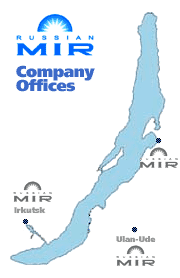Golden Chain of the Transsiberian.
TransSib
The earliest plans for long distance railways in Siberia came from a number of foreigners. They were English engineers Thomas Duff, John
Milburne and William Lawrie. In 1881 Alexander III became Tsar and in 1886 gave the Trans-Siberian project his official sanctions. The railway committee decided that the great project should be divided into
several sections. The West Siberian Railway would run from Chelyabinsk
to the Ob River — to Novosibirsk. The Mid Siberian Railway would link
the Ob to Irkutsk, the capital of Eastern Siberia. Passengers would
cross Lake Baikal on ferries to Mysovaya, the start of the Transbaikalian Railway to Sretensk. From here they would continue to use the Shilka and Amur River for the journey to Khabarovsk, until the Amur Railway could be built between these towns. The Ussuri railway
would link Khabarovsk with Vladivostok. There were also plans for a shortcut from the Transbaikal area to Vladivostok, across Manchuria.
This was planned to be known as the East Chinese Railway.
If you imagined you would be hauled across Siberia by a puffing steam
locomotive you will be a bit disappointed. The Railway is converted to electricity. The carriages are solidly-built, warm in winter and each
stuffed by an attendant (provodnik in Russian).
Little wooden station buildings mushroom along the railway. The most
attractive thing during this trip is that you are able to see different
towns and sights right on your way.
You will be able to see such cities as Moscow, Novosibirsk, Irkutsk,
Khabarovsk, Nakhodka, Yokohama on your Trans-Siberian Route. Ulan-Ude,
Ulan-Bator and Beijing can be found on the Trans-Mongolian branch of the route. Chita, Harbin and Beijing are included in the Trans-Manchurian Route.
The Trans-Siberian is indeed, as Annette Meakin wrote in 1900, a veritable «Liberty Hall». Do what you want and «time passes very
pleasantly on such a train».
Circum Baikal old Railway
The Circum-Baikal line was the most complicated and costly leg of the great Trans-Siberian Railway. The Trans-Siberian Railway itself
stretches from Moscow in the West all the way to Vladivostok in the East. Begun in 1891 under the patronage of Tsar Alexander III, the railway had reached Irkutsk near the rocky shores of Lake Baikal by 1898. There the construction halted while engineers considered their
options: send the train-cars across the lake on ferries, or lay track
along the steep lake shore, cutting through the outcroppings and ledges
that plunge down into the lake.
The decision was made to continue the tracks along the shore of the Angara River to the lake, and to load the train cars onto ferries for the crossing. One of the original ice-breaker ferries still remains in Irkutsk, housing the Museum of Baikal Navigation.
During deep winter when the lake ice was thick, workers laid track on the frozen lake, and horses hauled the carriages from shore to shore.
No arrangement could keep up with the volume of rail traffic, and the area proved to be a bottleneck for passengers and freight.
In the spring of 1902, after years of planning, crews began working on the Circum-Baikal line. The 53-mile track required 39 tunnels and 440 bridges. For the first time in Russia, electric power was used to cut through the six longest tunnels. Italian and Albanian bricklayers,
considered to be the best in the world at that time, finished the walls
of the tunnels. By August of 1904, the first trains began to run on the single-track line. A second track was being laid from 1922- 1915.
The Circum-Baikal was called the «Golden Buckle» of the Trans-Siberian,
because it linked the two parts of the railway with each other, and because it was so costly to construct. Trains ran on the line until
1956, when a new dam on the Angara came to threaten to flood the Irkutsk-Baikal tracks.
Today the main Tran-Siberian line runs from Irkutsk down to the southern end of Lake Bailkal, bypassing the scenic Circum-Baikal
section.
Trains still run on the Circum-Baikal, however, taking tourists from
all over Russia as well as international travelers through the tunnels
and across the bridges of this historic and beautiful engineering
marvel.
27.05.2008
|


Our address
670000, Ulan-Ude,
Profsoysnaya Street, 31
Tel/Fax Ulan-Ude:
8 (3012) 216-177
664025, Irkutsk,
Rossiyskaya Street, 6. Office 2
Tel/Fax Irkutsk:
8 (3952) 342-043
ICQ: 616-858-802
Skype: russianmir
e-mail: russian-mir@yandex.ru
Certif. РОСС.RU.АЮ03.У00830

|

